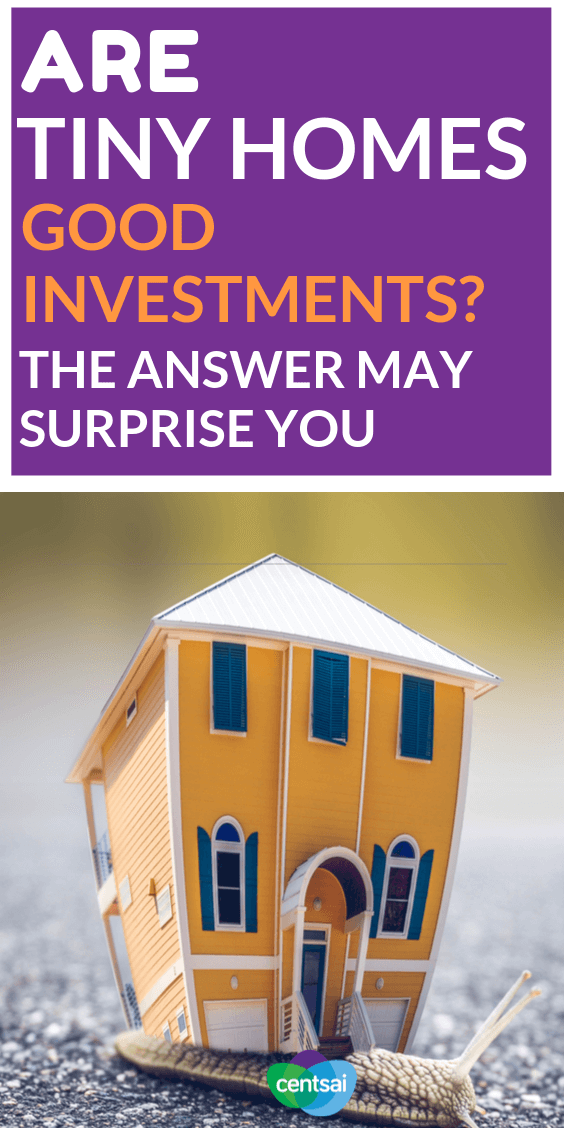
Tiny homes.
Just saying the name brings to mind images of adorable rolling cottages, cutting-edge lifestyles, and minimal possessions and worries.

We’ve all seen the TV shows, listened to the podcasts, and fantasized a bit about living in a home in the forest or on a plot of land near a creek.
For those saddled with debt, the idea of a tiny home that costs less than $20,000 sounds like a great idea. Buying a standard house means spending money on a down payment, insurance, interest, and taxes, not to mention maintenance over time.
The down payment alone is an extreme obstacle to 62 percent of millennials who would not be able to afford a home, according to a survey by Apartment List, while an additional 29 percent claim that the monthly payments would be a severe financial burden.
This begs the question: Given their low cost, are tiny homes good investments?
How much does living the “tiny life” actually cost, and what kind of resale value can you expect from owning a tiny house?
Options to Add Additional Coverages
What Are Tiny Homes?
In a few words, the tiny home movement is an effort to combat the prevalence of McMansions. It’s about reducing the size of the space you live in, meaning that many tiny homes are under 500 square feet. They can be made from vans, miniature constructions, or even from storage containers that real estate entrepreneurs like Janelle Briggs provide.
In the United States, there are more than 10,000 tiny homes, according to Go Downsize, and the trend seems to be rising.
Tiny-home dwellers may downsize for a variety of reasons — environmental concerns, financial difficulties, or simply for flexibility and freedom. Many tiny homes are mobile, so you can take them wherever you want.
What Kind of Investment Is a Tiny Home?
One of the things people love most about tiny homes is their endless customizability, which also makes it difficult to answer the question of how much tiny homes cost.
Given that they are easily personalized, this makes it difficult to find an average price for tiny homes, as size, materials, and finishes can vary greatly. The figure runs from about $8,000 for a DIY tiny home with minimal fixtures all the way up to $150,000 and beyond for a custom-built tiny home with luxe fittings and features, according to Home Advisor.
The biggest factors in pricing out a tiny home are materials and labor costs. Anyone who’s worked with a contractor can tell you that those items aren’t cheap.
If you’re willing to do a large portion of the work yourself, you can significantly lower the cost of your home. When looking at a tiny home as an investment, you have to put a dollar value on your own labor. This tells you the real cost, in both money and time spent, of building one.
Materials are the next largest pricing factor.
If you’re savvy and willing to spend some time researching, you can often find reclaimed materials or leftovers from a job site.
There are entire stores that sell nothing but the extra parts and slightly damaged fixtures from major building companies. These stores are often local businesses, so a quick Google search should bring up the appropriate place to go depending on your location.
Tiny living can be either inexpensive or about the cost of a small starter home. Try finding a $100,000 home with truly top-of-the-line fittings.
The Cost of Living in a Tiny Home
Living in a tiny home can be incredibly affordable. Heating, cooling, and cleaning 300 square feet is a whole lot cheaper and easier than doing so for a 2,322-square-foot home (the median new home size in 2019, according to the U.S. Census Bureau).
You can reduce your water, power, and other bills even further if you choose to live a sustainability focused lifestyle.
Solar panels, well water, and options such as a wood stove for heating can drop your living expenses substantially and shrink your carbon footprint.
There are other expenses to consider, though, especially if you’re living in a tiny house on wheels and plan to travel. Gas, insurance, and campground fees can add up fast.
Finding a Place to Live
One thing that you have to take into account when considering the cost and value of tiny living is where you live. Most American cities aren’t tiny-home friendly. Many zoning laws prohibit full-time tiny-home habitation across the board.
Even if you plan to stay in one place, you have to find land that allows tiny homes and has the necessary improvements with water, sewage, and electrical hookups. Many tiny-home dwellers get around this by living on family land or going out into a more rural area.
If you’re more sustainably minded, a tiny home is one of the best ways to explore alternative lifestyles. This allows you to disconnect from traditional ways of Western life and see what living off the grid can be like.
The Resale Market
If you just go by all the reality shows and hype you’d think the tiny home market was absolutely booming. The reality is, well, a tiny bit different.
Tiny homes are popular, in a big way. But that doesn’t mean that everyone, or even most people, are willing to live in one.
Ask any real estate agent about home renovations, and they’ll advise you to go for broader appeal. Look for the improvements that match the largest portion of the market’s taste and try not to over customize.
About 56 percent of Americans would consider living in a tiny home, according to a survey by IPX 1031, a Fidelity National financial company. Anything that has such a limited market — or liquidity — is going to be harder to sell.
Taking Out a Loan
The biggest selling point for tiny homes is that you don’t need to take out a mortgage, according to Hannah Maman, a real estate agent in Phoenix.
You won’t find a traditional home loan for a tiny house because most mortgage lenders have minimum loan amounts that are much higher than the one needed for a tiny house.
Additionally, typical mortgage lenders won’t give out a loan because many tiny houses are on wheels/transportable and not on a foundation, and most lenders require a permanent foundation.
That said, Maman explains that you can finance directly through a builder or take out either a personal loan or an RV loan. If you are to take out an RV loan for a tiny house, it must first be certified under the Recreational Vehicle Industry Association (to show it’s safe for the road). You can expect to get about 4 to 9 percent interest rates here on a term of 70 to 85 months.
However, if you aren’t association certified and would rather take out a personal loan, this is doable. It would just be an unsecured personal loan with a higher interest rate, in the 7 to 11 percent range.
“So many individuals are struggling with debt and are looking for viable alternatives to being locked into a 30-year mortgage,” Maman says.
“Even maintenance and utility bills are cut in half, which saves people a ton of money.”
On the other hand, Maman states, “I think people need to be aware that buying a tiny home, in most cases, isn’t the same as buying a traditional home.” Continue reading below to find out why this kind of investment may not be for you.
Do Tiny Homes Appreciate in Value?
Best answer: It’s complicated. Traditional wisdom tells us owning a house over a long period of time — say at least five years — can be a good way to grow your money. After all, don’t homes grow in value over time?
Not always.
The land that your home sits on may appreciate in value, but the physical house is actually depreciating. The same thing holds true for tiny homes, with the added twist that you don’t usually own any land under them.
Don’t expect your tiny home to appreciate in value like a traditional home, advises Noaz Miller, a home-insurance specialist in Scottsdale, Arizona. Location is the key factor that predicts valuation, he adds.
“Land typically appreciates or depreciates with the local market,” Miller says. Any traditional home with a permanent foundation will have better resale value than a tiny home on wheels, which will depreciate in value like an RV.
Tiny Homes as Passive Income Investments
If you’re renting out a tiny home, it could be a source of passive income, as is any other rental property. But be aware that there are a host of considerations to consider before becoming a landlord, such as state and local laws.
A landlord should use a legally reviewed template for their state when creating a lease. States vary in terms of their protections for tenants and landlords, so ensure you protect yourself as much as possible in the event that any tenant falls far enough behind on rent that legal intervention is needed.
One should also take into careful consideration the financial aspects of maintaining the property. Last, be sure to screen your tenants. As problems arise, you will likely be the one responsible for fixing them.
The Downsides of Tiny Homes
If you’re interested in living in a tiny home, take care to consider the effects that the size of tiny homes can have on your life. Sure, it would be awesome to travel the world in a tiny home on wheels, but the little rational voice might start screaming, “No! You don’t have a remote job, so you can’t just pick up and go.”
You also may need more than 500 square feet of space. If you ever intend to host friends and have family stay with you, you need more than one bedroom and bathroom.
Not to mention the difficult regulations that you would have to abide by if you built your own tiny home. Most tiny homes have wheels to avoid the zoning laws in the city, leaving owners scrambling to find a place to park it legally. Some might be able to put it in the backyard of a regular home, but the area must have the proper zoning to accommodate full-time camping.
If the tiny house has a foundation and isn’t on wheels, it would have to comply with building codes, which usually means it must be a minimum of 700 square feet. For that reason, many people turn to rural areas where land is less expensive to build and park their tiny homes.
But if you’re a city person, it may not be practical for you to live out in the woods.
The Bottom Line
A tiny home can be a great investment for the right person. If you want to build your own house, travel the country with it, and embrace an alternative lifestyle, a tiny home can be an affordable way to accomplish this.
You can customize the home almost endlessly and save money on rent and utilities. It also allows you to take the comforts of home to all kinds of wild and beautiful places.
If you want to go tiny with an eye toward reselling your home down the line and realizing gains, you may be disappointed. Tiny homes depreciate and can be difficult to sell, so they might not make good investments in that sense. And if you want to live in a major city, it can be difficult and expensive to find somewhere to do so.







